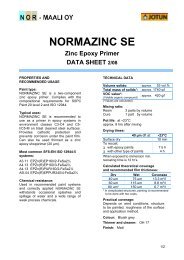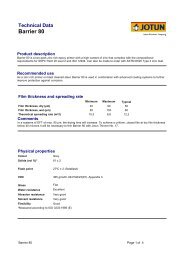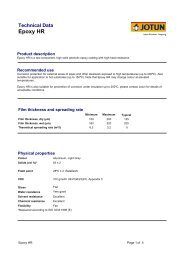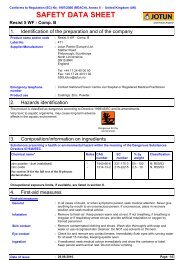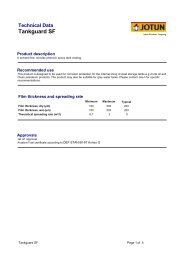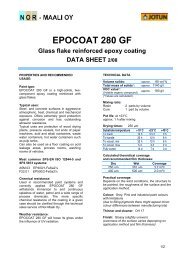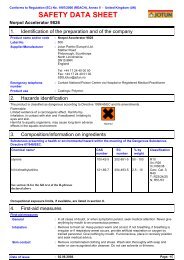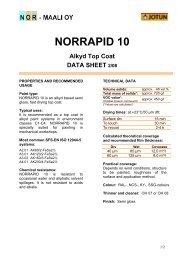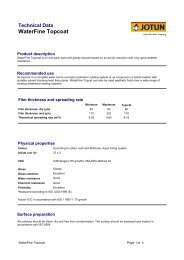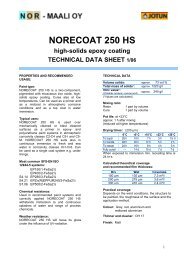Jotun Zinc 100 Comp B
Jotun Zinc 100 Comp B
Jotun Zinc 100 Comp B
You also want an ePaper? Increase the reach of your titles
YUMPU automatically turns print PDFs into web optimized ePapers that Google loves.
Conforms to Regulation (EC) No. 1907/2006 (REACH), Annex II - United Kingdom (UK)<br />
<strong>Jotun</strong> <strong>Zinc</strong> <strong>100</strong> <strong>Comp</strong> B<br />
SECTION 2: Hazards identification<br />
2.3 Other hazards<br />
Other hazards which do not<br />
result in classification<br />
:<br />
Not available.<br />
SECTION 3: <strong>Comp</strong>osition/information on ingredients<br />
Substance/mixture<br />
Product/ingredient<br />
name<br />
:<br />
Mixture<br />
Identifiers<br />
zinc EC: 231-175-3<br />
CAS: 7440-66-6<br />
zinc oxide REACH #: 01-<br />
2119463881-32<br />
EC: 215-222-5<br />
CAS: 1314-13-2<br />
Index: 030-013-00-7<br />
% 67/548/EEC Regulation (EC) No. Type<br />
1272/2008 [CLP]<br />
>=90 N; R50/53 Aquatic Acute 1, H400<br />
Aquatic Chronic 1,<br />
H410<br />
2,5-25 N; R50/53 Aquatic Acute 1, H400<br />
See Section 16 for<br />
the full text of the R-<br />
phrases declared<br />
above.<br />
Classification<br />
Aquatic Chronic 1,<br />
H410<br />
See Section 16 for<br />
the full text of the H<br />
statements declared<br />
above.<br />
[1] [2] -<br />
[1] -<br />
Notes<br />
There are no additional ingredients present which, within the current knowledge of the supplier and in the concentrations<br />
applicable, are classified as hazardous to health or the environment, are PBTs or vPvBs or have been assigned a<br />
workplace exposure limit and hence require reporting in this section.<br />
Occupational exposure limits, if available, are listed in Section 8.<br />
SECTION 4: First aid measures<br />
4.1 Description of first aid measures<br />
General<br />
: In all cases of doubt, or when symptoms persist, seek medical attention. Never give<br />
anything by mouth to an unconscious person. If unconscious, place in recovery<br />
position and seek medical advice.<br />
Inhalation<br />
: Remove to fresh air. Keep person warm and at rest. If not breathing, if breathing is<br />
irregular or if respiratory arrest occurs, provide artificial respiration or oxygen by<br />
trained personnel.<br />
Skin contact<br />
: Remove contaminated clothing and shoes. Wash skin thoroughly with soap and water<br />
or use recognised skin cleanser. Do NOT use solvents or thinners.<br />
Eye contact<br />
: Check for and remove any contact lenses. Immediately flush eyes with running water<br />
for at least 15 minutes, keeping eyelids open. Seek immediate medical attention.<br />
Ingestion<br />
Protection of first-aiders<br />
:<br />
If swallowed, seek medical advice immediately and show the container or label. Keep<br />
person warm and at rest. Do not induce vomiting.<br />
: No action shall be taken involving any personal risk or without suitable training. It may<br />
be dangerous to the person providing aid to give mouth-to-mouth resuscitation.<br />
4.2 Most important symptoms and effects, both acute and delayed<br />
Potential acute health effects<br />
Eye contact<br />
: No known significant effects or critical hazards.<br />
Inhalation<br />
: No known significant effects or critical hazards.<br />
Skin contact<br />
: No known significant effects or critical hazards.<br />
Ingestion<br />
: No known significant effects or critical hazards.<br />
Over-exposure signs/symptoms<br />
Eye contact<br />
Inhalation<br />
Skin contact<br />
: No specific data.<br />
:<br />
:<br />
No specific data.<br />
No specific data.<br />
Date of issue : 06.02.2013.<br />
2/10



